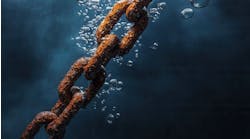Rubber toughened urethane resists wear and limits vibration
ProCoat Nordic is introducing one of the most versatile rubber products on the offshore market today. A unique process transforms used tires into a solvent free substance that can be sprayed onto almost any surface to create a layer of rubber toughened urethane that is resistant to wear and abrasion, corrosion and reduces noise and vibration.
ProCoat can be applied in thicknesses ranging from 1.5 mm and upwards to many cm. This makes it suitable for tasks such as deck coatings, noise reduction and protection, vibration damping, ice inhibition and the construction of fenders and rubbing strakes.
The material was invented at the Royal Institute of Technology in Stockholm in 1977. Since then, it has been developed into a complete two component coating that is applied by electrically or pneumatically powered spray equipment operated by certified applicators.
Although ProCoat has now been in use for several years, ProCoat Nordic was only established in June 1999 and is now developing a global marketing network.
ProCoat is manufactured through vacuum technology in a process that adds raw materials at different stages. The two components of ProCoat are automatically mixed by the sprayer to ensure a homogenous and long lasting surface coating.
The product can also be mixed and applied by hand for making minor repairs. The system is resistant to many chemicals, especially to acids and alkaline solutions in a broad temperature range. It is available in a range of colors and with an anti-slip silicate additive.
ProCoat is useful as a lightweight alternative to asphalt on bridge and road surfaces. It is naturally resistant to ice formation but can also be applied in a thickness to contain heating elements that will eliminate any ice build-up in more extreme conditions.
A less typical, but highly successful, use of ProCoat solved a difficult problem for Finnjet, which operates ferries between Germany and Finland. The uneven flow of water over the ferry's two rudders was causing cavitation which resulted in the small air bubbles exploding against the metal surface to cause significant pitting and erosion of the surface of the rudder.
A 5-mm layer of ProCoat was applied to one of the rudders in 1996 while the other was left untreated so that a comparison could be made. Because the rubber absorbs the energy of the vibration, the treated rudder showed no signs of wear after two years of operation in the Baltic Sea. This resulted in the second rudder being treated with ProCoat in 1998, and saving the cost of rudder replacement in the process.
For further information, contact Lars Larsson, ProCoat Nordic AB, Tel: +46 8 590 910 50, Fax: +46 8 590 910 53, Email: [email protected]


